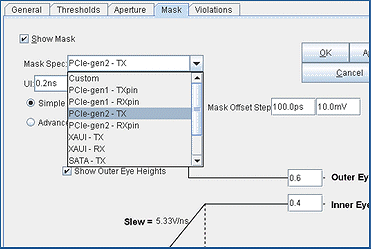Automated DDR3 Analysis

Quantum-SI 2008.04 automates signal integrity and timing analysis of DDR3 interfaces. Enhancements include new DDR3-specific waveform quality checks and modeling of dynamic timing behaviors (write and read-leveling). Quantum-SI simplifies the process of perform pre- and post-route DDR3 design analysis, allowing designers to quickly establish their design's operating timing and voltage margins.
DDR3 Signal Integrity Enhancements
The JEDEC DDR3 specification (JESD79-3A) defines a new waveform quality parameter, Time Beyond VAC, or TVAC. This parameter defines the length of time a signal must spend beyond the AC thresholds in order for a transition to be considered valid. This time is dependent on the slew rate of the signal at the receiver input.

Ref: JESD79-3A, Page 162, Figure 101
Quantum-SI 2008.04 adds parameters the IBIS model that allow Quantum-SI to automatically determine whether TVAC requirements are being violated during waveform processing. Violations are automatically flagged and included in the Waveform and Timing report. Violations may also be annotated directly onto waveforms in the SiViewer simulation results display.
DDR3 Timing Analysis Enhancements
Quantum-SI 2008.04 supports two different types of timing models for DDR3 controllers:
Programmable timing models allow the user to directly control timing between CK and DQ/DQS on a per-lane basis. These models are used to represent controllers that do not implement training sequences and do not perform automatic write-leveling. The timing model in Quantum-SI is set up with the same tap offsets programmed in the actual system, and Quantum-SI performs integrated signal integrity and timing analysis to predict the system's operating margins.
Dynamic timing models are used for controllers that support automatic write leveling. The timing model describes the controller's ability to adjust its output timing, listing minimum / maximum adjustments and tap resolution. Quantum-SI combines this information with the results of SI simulations to determine the design's optimal design margins (based on infinite tap resolution) and actual design margins (based on the controller's actual capabilities and tap resolution). Quantum-SI also predicts which tap settings the design will use during actual operation. The resulting information is output in the Waveform and Timing report, as shown below.

Users can utilize this new section of the Waveform and Timing report even if they aren't using a device with programmable output timing. Quantum-SI always computes and displays the optimal timing shift for centering design margins, even when the driving device doesn't have adjustable output timing. Designers can use this information to implement a timing shift using PCB etch to center design setup/hold margins. Thus, this new report can be used to drive post-route timing adjustments for designs other than DDR3 interfaces.
DDR3 Design Kits
Architectural Design Kits are available for both registered and unbuffered DDR3 implementations. These kits are free to Quantum-SI users under maintenance and can be obtained through regular support channels. Implementation kits are available for select controllers and memory configurations, and customized kits can be developed on demand. For more information on DDR3 Implementation kits, please contact your SiSoft Sales Representative.
SiViewer Enhancements
Waveform Violation Integration
Waveform violations flagged by the Quantum-SI engine during waveform processing can now be annotated directly on the waveform display. Users can control which classes of violations are annotated under "Display Preferences / Violations". More information about a specific waveform violation can be obtained by positioning the cursor over one of the violation markers, which causes the violation details to be displayed in a pop-up window, as shown below:

S-Parameter Display Improvements
SiViewer can directly open S-parameter files and display the data. The 2008.04 release includes numerous display and robustness improvements, including the ability to display results for sparsely populated S-parameter data sets.
Eye Mask Library
A library of standard eye masks is now included with SiViewer, which allows masks to be selected from a drop-down menu. Users can quickly customize and add their own definitions to the eye mask library, which includes support for both simple and advanced compliance masks.